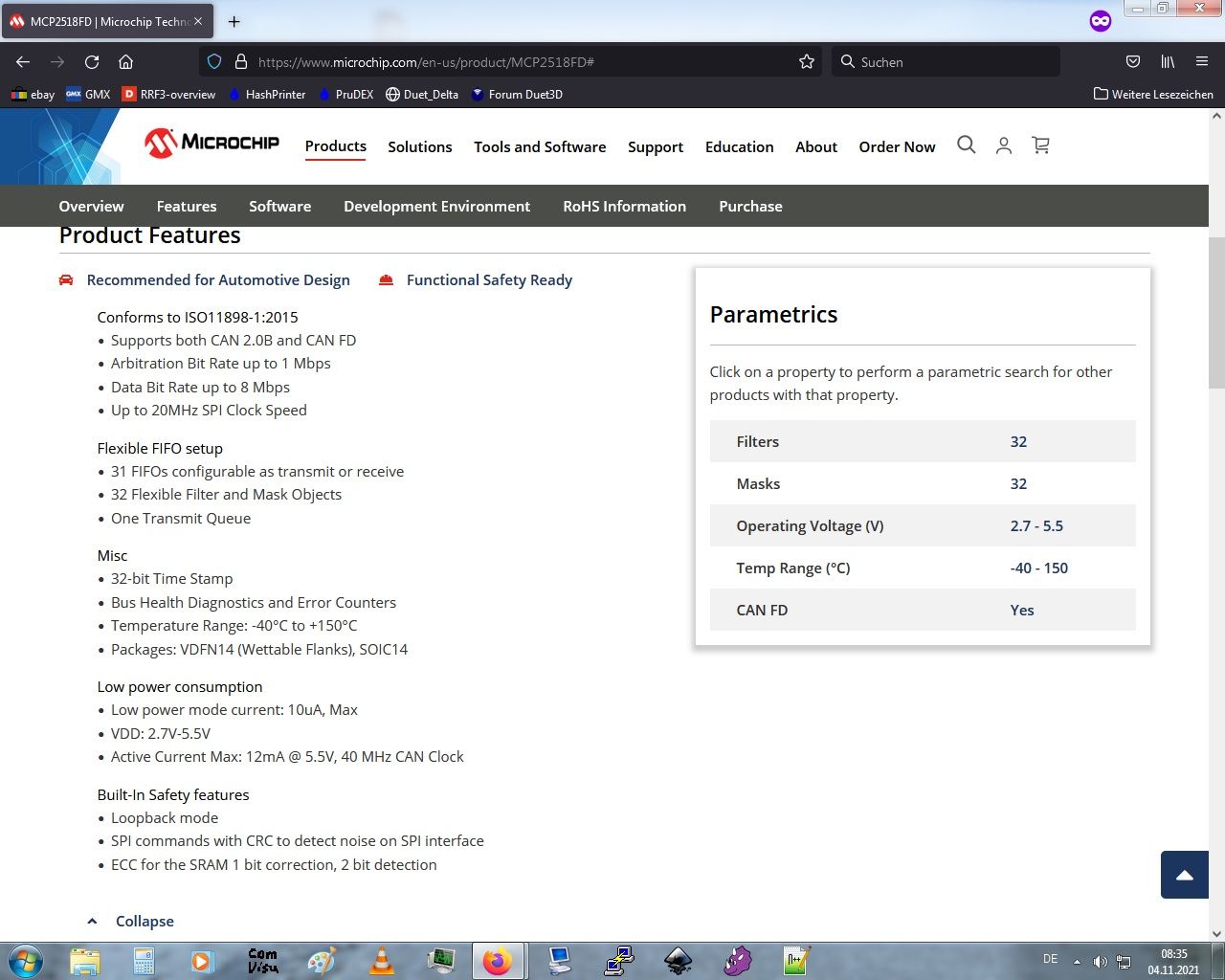New Raspberry Pi Zero 2W
-
@o_lampe I may be wrong but I think that those pio blocks are part of the rPi silicon and not part of the Arm core.
Most of these devices are a combination of a core from Arm plus manufacturer specific peripheral devices. So for instance the SPI device on an STM mcu is more than likely totally different to the SPI devices on a microchip mcu even if they both have the same Arm core. Things get a little bit more confusing though because Arm does provide some standard peripheral designs, that some manufacturers may use (or I think can even modify). So for instance the the SSP device on the LPC1768 (which provides SPI functionality) is actually an ARM PrimeCell Synchronous Serial Port (PL022).
-
@gloomyandy said in New Raspberry Pi Zero 2W:
pio blocks are part of the rPi silicon and not part of the Arm core.
Yes they are rpi specific
Some Atmel/Microchip processors have a similar (but much more limited) idea called "configurable custom logic" designed as hardware "glue logic".
@o_lampe said in New Raspberry Pi Zero 2W:
PIO statemachines .....I assume RRF uses them for pulse generation
We do not as they are Rpi 2040 specific. Although we have considered a range of options for pulse generation.
@o_lampe said in New Raspberry Pi Zero 2W:
If we could integrate CAN-FD as PIO state machine in M0(Pico) hardware, we would only need a tranceiver...
Yes, that would be great, anyone found an example of CAN or a similar protocol implemented on 2040 statemachines, with a reference for what bus speeds could be accommodated?
@PCR using that CAN-FD bus IC & transceiver with a Pi (either directly on a Pi 2/3/4, or using a 2040 + USB to a PC) could certainly allow for bus monitoring and protocol diagnosis, independent of using an oscilloscope so that could be interesting.
Alternatively it might allow Klipper or similar to use Duet 3 expansion boards w/o a mainboard, they could implement the Duet CAN-FD protocol on the pi and send the planned moves to each board....
-
@t3p3tony said in New Raspberry Pi Zero 2W:
Alternatively it might allow Klipper or similar to use Duet 3 expansion boards w/o a mainboard, they could implement the Duet CAN-FD protocol on the pi and send the planned moves to each board....
That would be really great for slicing&pre-processing of multi-stream gcode
-
@o_lampe neither of those is really specific to klipper though. slicing sits outside of the firmware used and if you are using a Pi then DSF allows you to intercept and modify the gcode.
-
@t3p3tony I just wanted to point out, that an SBC can do so much more for us, then just display DWC.
-
@t3p3tony said in New Raspberry Pi Zero 2W:
Alternatively it might allow Klipper or similar to use Duet 3 expansion boards w/o a mainboard, they could implement the Duet CAN-FD protocol on the pi and send the planned moves to each board....
Does the duet main board send move commands over CAN in real time or does it just sync clocks and then send queued moves with target start time?
The former will put hard realtime constrains on the SBC, the later is more relaxed.
As for the Pico's PIOs, they are awesome. The stepper analyzer uses them to write to the display which achieves a significant boost. Typically they communicate with the software via hardware fifos that can be accessed programmatically or by DMA. For example, the MCU (there are two of them) can write the stepper pulse commands (e.g. interval and direction) to a double buffer and trigger a DMA to send them to the pio. Also, the the RP2040 are very cheap but like many other chips these days are hard to get.
For CAN bus implementation, I would check in the Pico forums, they also have strong presence from the vendor. https://forums.raspberrypi.com/viewforum.php?f=143
-
@zapta That's really good news about the PIOs. I hope we can gain enough interest and gather some SW-experts to make the best possible gadget.
I still hope it's not all CAN related, for the sake of Duet2 owners...BTW: Berrybase.de still has almost 20.000 of them in stock.
-
I played a bit with the Z2W and compared it with a RPi3b. They have the same cpu, but the Z2W constantly uses the swap-file in GUI mode.
I even had to increase the swap-size (default only 100MB)
The eMMC-uSD card I also bought, has no significant speed gain over class 10 SD card. (RPi4 benchmarks are much better)My first impression: if you already have a RPi3 or better, and @PCR 's CAN-FD Hat will fit there too, there's no reason to spend extra money for a Z2W.
The Pico is still interesting as a low level CoPro. Time will tell... -
@t3p3tony said in New Raspberry Pi Zero 2W:
@PCR using that CAN-FD bus IC & transceiver with a Pi (either directly on a Pi 2/3/4, or using a 2040 + USB to a PC) could certainly allow for bus monitoring and protocol diagnosis, independent of using an oscilloscope so that could be interesting.
I read more about Pico's PIO state machines and there is a sample code about a logic analyzer (16 channel IIRC). Just thought it was worth mentioning it in this context.
-
While the PIO state machines look very useful, the amount of instruction memory (32 instructions) and scratchpad memory (2x 32 bits) are nothing like enough to implement a protocol with the complexity of CAN-FD.
-
@dc42 I felt the same, when I studied the CanHack.py program. So we'd need both Can chips to make it work.
-
@dc42 said in New Raspberry Pi Zero 2W:
While the PIO state machines look very useful, the amount of instruction memory (32 instructions) and scratchpad memory (2x 32 bits) are nothing like enough to implement a protocol with the complexity of CAN-FD.
@dc42, I am not familiar with CAN bus. What does the PIO need to do other than serializing bits in/out or detect collisions? Those PIO instructions are very capable (they have multiple fields and can do a few things in one instructions) and work well with the the hardware FIFOs, DMAs, and MCU interrupts.
-
@zapta The CanHack program lists many subroutines for testing and demonstration purposes and some real life routines. They are usually only a few lines of code. In C++ they might even be more compact.
But for compatibility reasons beween Pico(with state machines) and Z2W(no state machines), the Can-Hat should have both Can chips anyway... -
@o_lampe, I see here two pdf schemas, one with a can controller and one with just the transceiver. What's the difference between them? Can the one without the MCP2518FD still support CAN functionality? Why two versions?
-
@zapta I'm no CAN expert either, but it seems it has some FiFo buffers, filters and CRC check of the SPI bus. The 40MHz crystal is another feature for better CAN-performance and reliability.

-
 undefined o_lampe referenced this topic
undefined o_lampe referenced this topic
-
@ALL
there's a dual CAN-FD Hat for RPi from Seeedstudio
Does anyone see a reason, why this wouldn't work for SBC-purposes? (pins or I/O channels already in use)@PCR
would it still make sense to design our own version? -
@o_lampe the raspberry pi shield might be a way to add CAN-FD in setups where it's not natively available, such as duet 2 + SBC and the STM/LPC port
-
@jay_s_uk Yep problem is that the Shield is using SPI i think?
-
@jay_s_uk said in New Raspberry Pi Zero 2W:
the STM/LPC port
The super8 has a Can-Port, but it's not (yet) supported? OTOH, I wouldn't know how to link a RPi?
-
@o_lampe it does but it's only CAN over serial for the klipper guys